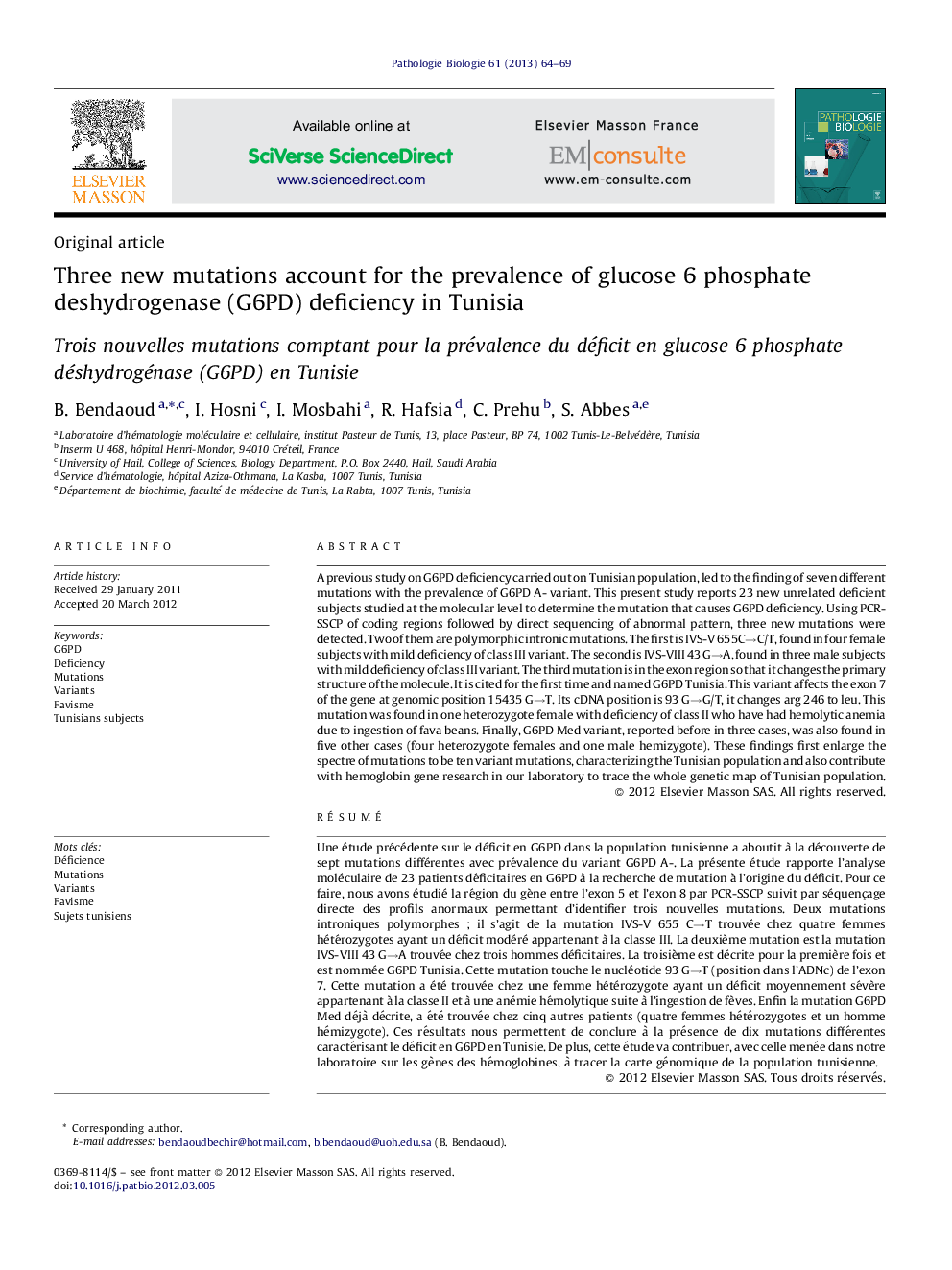| کد مقاله | کد نشریه | سال انتشار | مقاله انگلیسی | نسخه تمام متن |
|---|---|---|---|---|
| 4136053 | 1271893 | 2013 | 6 صفحه PDF | دانلود رایگان |

A previous study on G6PD deficiency carried out on Tunisian population, led to the finding of seven different mutations with the prevalence of G6PD A- variant. This present study reports 23 new unrelated deficient subjects studied at the molecular level to determine the mutation that causes G6PD deficiency. Using PCR-SSCP of coding regions followed by direct sequencing of abnormal pattern, three new mutations were detected. Two of them are polymorphic intronic mutations. The first is IVS-V 655C→C/T, found in four female subjects with mild deficiency of class III variant. The second is IVS-VIII 43 G→A, found in three male subjects with mild deficiency of class III variant. The third mutation is in the exon region so that it changes the primary structure of the molecule. It is cited for the first time and named G6PD Tunisia. This variant affects the exon 7 of the gene at genomic position 15435 G→T. Its cDNA position is 93 G→G/T, it changes arg 246 to leu. This mutation was found in one heterozygote female with deficiency of class II who have had hemolytic anemia due to ingestion of fava beans. Finally, G6PD Med variant, reported before in three cases, was also found in five other cases (four heterozygote females and one male hemizygote). These findings first enlarge the spectre of mutations to be ten variant mutations, characterizing the Tunisian population and also contribute with hemoglobin gene research in our laboratory to trace the whole genetic map of Tunisian population.
RésuméUne étude précédente sur le déficit en G6PD dans la population tunisienne a aboutit à la découverte de sept mutations différentes avec prévalence du variant G6PD A-. La présente étude rapporte l’analyse moléculaire de 23 patients déficitaires en G6PD à la recherche de mutation à l’origine du déficit. Pour ce faire, nous avons étudié la région du gène entre l’exon 5 et l’exon 8 par PCR-SSCP suivit par séquençage directe des profils anormaux permettant d’identifier trois nouvelles mutations. Deux mutations introniques polymorphes ; il s’agit de la mutation IVS-V 655 C→T trouvée chez quatre femmes hétérozygotes ayant un déficit modéré appartenant à la classe III. La deuxième mutation est la mutation IVS-VIII 43 G→A trouvée chez trois hommes déficitaires. La troisième est décrite pour la première fois et est nommée G6PD Tunisia. Cette mutation touche le nucléotide 93 G→T (position dans l’ADNc) de l’exon 7. Cette mutation a été trouvée chez une femme hétérozygote ayant un déficit moyennement sévère appartenant à la classe II et à une anémie hémolytique suite à l’ingestion de fèves. Enfin la mutation G6PD Med déjà décrite, a été trouvée chez cinq autres patients (quatre femmes hétérozygotes et un homme hémizygote). Ces résultats nous permettent de conclure à la présence de dix mutations différentes caractérisant le déficit en G6PD en Tunisie. De plus, cette étude va contribuer, avec celle menée dans notre laboratoire sur les gènes des hémoglobines, à tracer la carte génomique de la population tunisienne.
Journal: Pathologie Biologie - Volume 61, Issue 2, April 2013, Pages 64–69